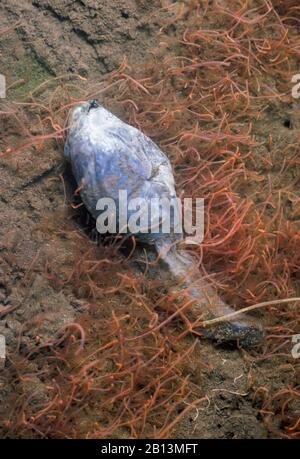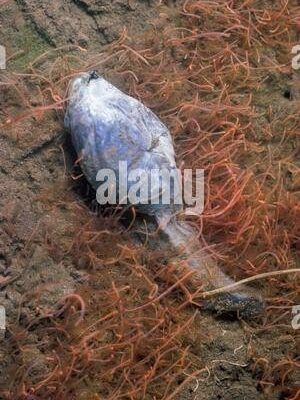
Let’s dive into the world of tubifex worms. Unlike the more common earthworms we see in gardens, these guys have a unique habitat and lifestyle. You might be surprised to learn just how significant they are in keeping our water ecosystems thriving, along with some interesting facts about their biology and behavior. So, grab your metaphorical dive gear, and let’s explore what makes tubifex worms so special!
What Exactly Are Tubifex Worms?
Tubifex worms belong to the family Tubificidae and are closely related to other aquatic worms. They are typically found in muddy, oxygen-poor environments, like lakes, ponds, and wetlands. You might be thinking, “Why do they prefer these less-than-ideal places?” The answer lies in their amazing adaptations. Tubifex worms can tolerate low oxygen levels better than many other organisms, making them experts at surviving in challenging conditions.
These worms can grow up to 10 centimeters long, and their bodies are often reddish-brown or pinkish in color. The structure of their bodies allows them to wriggle through the mud easily. It’s almost like they’re designed specifically for sifting through sediment, which is exactly what they do. As they go about their day, they absorb nutrients and organic matter from the sediment around them—turning the muck into a valuable resource for the ecosystem.
The Role of Tubifex Worms in the Ecosystem
You might be surprised to learn just how crucial tubifex worms are in their habitats. They’re like nature’s recyclers, breaking down organic material and making nutrients available for other organisms. This process is essential for promoting healthy aquatic environments. Without tubifex worms, we’d see a buildup of debris, which could lead to poor water quality and unhealthy ecosystems.
Their presence also supports a food web. Many aquatic creatures, like fish, amphibians, and even some birds, enjoy a meal of tubifex worms. So, when we consider the big picture, these little worms contribute to the survival of various species. It’s a classic case of how even the smallest creatures can have a significant impact on their surroundings.
How Do Tubifex Worms Reproduce?
Reproduction in tubifex worms is nothing short of fascinating. They can reproduce both sexually and asexually, which is pretty unique. In sexual reproduction, male and female worms come together to exchange sperm, leading to the development of fertilized eggs. When it comes to asexual reproduction, these worms can simply split in half and regenerate their missing parts, creating a new worm in the process.
This ability to reproduce in multiple ways helps them thrive in unpredictable environments. Tubifex worms often produce cocoons that contain multiple eggs, which can survive in harsh conditions. Imagine the blob of jelly-like substance protecting these potential little worms until they can hatch. It’s an ingenious survival strategy!
Where Can You Find Tubifex Worms?
If you want to spot tubifex worms in the wild, look for them where the sediment is soft and muddy—think the bottoms of ponds, slow-moving streams, or even marshy areas. They tend to congregate in high densities, making them easier to find when you dig into the mud.
In aquaculture and aquarium settings, tubifex worms are often used as live food for fish. If you’re considering adding them to your aquarium, they can be a great source of nutrition for your fish. Just make sure to source them responsibly to avoid introducing diseases.
The Benefits and Uses of Tubifex Worms
Not only do tubifex worms play an essential role in the ecosystem, but they also have some practical uses. In addition to being fish food, they can also be used in fish farming. Their nutrient-rich body makes them an excellent choice for feeding various aquatic species.
In scientific research, tubifex worms are often used to study the effects of pollutants in aquatic environments. Their unique physiology allows researchers to understand how different substances impact water quality. So, while they may look like unassuming mud wigglers, tubifex worms offer valuable insights into environmental health.
Common Misconceptions About Tubifex Worms
There are quite a few myths surrounding tubifex worms. One common misconception is that they’re harmful or dangerous to humans or aquatic life. While it’s true that they can harbor bacteria, the risk is usually low, especially when sourced properly for aquariums.
Another myth is that all worms are the same. In reality, tubifex worms have unique adaptations and behaviors that set them apart from their terrestrial cousins. Understanding these differences is crucial for appreciating their role in nature.
Wrapping It Up
So, there you have it—a comprehensive look at tubifex worms! From their fascinating reproductive strategies to their vital role in the aquatic ecosystem, these worms are more interesting than one might first assume. They’re not just squiggly little creatures floating in the mud; they’re essential players in keeping aquatic environments healthy and balanced.
Next time you find yourself near a pond or stream, take a moment to appreciate the hidden wonders, like tubifex worms. They might just inspire you to delve deeper into the beauty and complexity of the natural world around us. Remember, every creature, no matter how small, has its part to play in the grand scheme of life!

